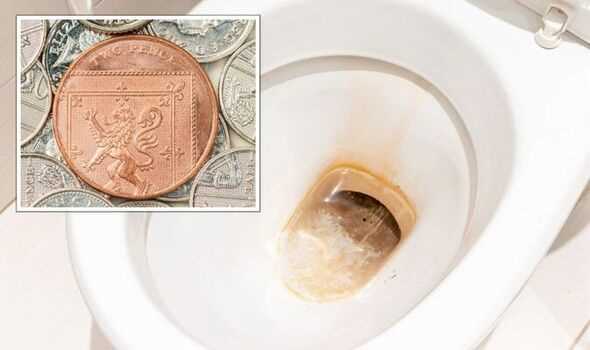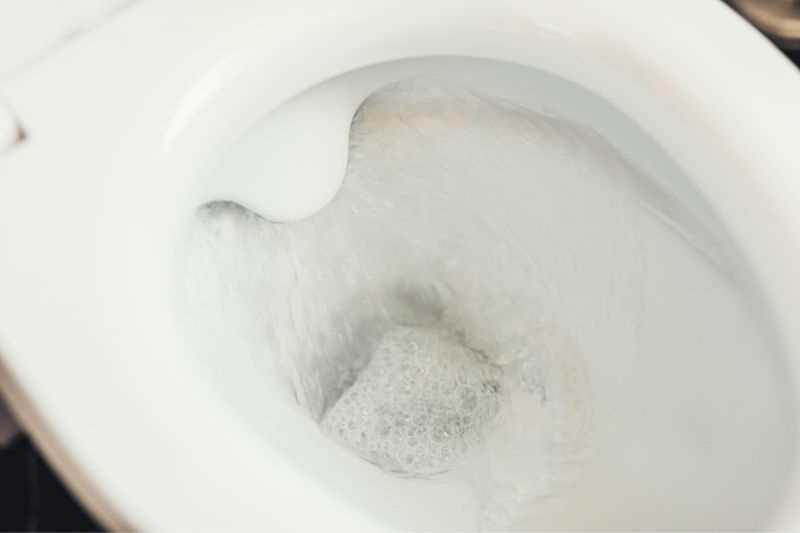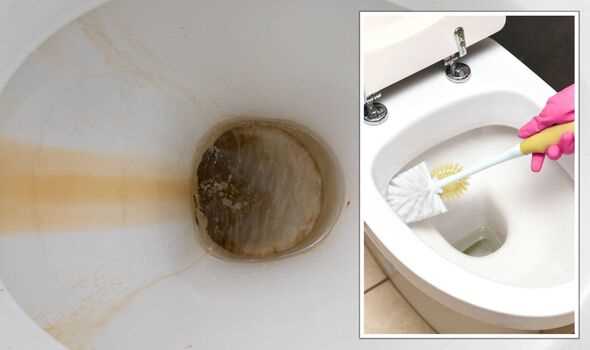




Limescale can be a stubborn problem in toilets, especially when it forms below the waterline. This unsightly buildup not only affects the appearance of the toilet bowl but also can lead to problems with flushing and drainage. Fortunately, there are several effective methods for removing limescale and restoring the cleanliness of your toilet.
One tried and true method for limescale removal is using vinegar. The acidic properties of vinegar make it an excellent natural cleaning agent. To use vinegar for limescale removal, simply pour a generous amount into the toilet bowl, ensuring that the vinegar reaches below the waterline. Leave it to sit for a few hours, or overnight if possible, before scrubbing the bowl with a toilet brush. The vinegar will break down the limescale, making it easier to remove.
If vinegar alone doesn’t do the trick, you can also try using a commercial limescale remover. These products are specifically designed to dissolve and remove limescale buildup. Follow the instructions on the product packaging, ensuring that you apply the remover to the areas below the waterline. Leave it to work for the recommended amount of time, then scrub the bowl with a toilet brush to remove the loosened limescale.
For more stubborn limescale buildup, you may need to use a pumice stone. The pumice stone should only be used on porcelain toilets, as it can scratch other materials. Wet the pumice stone and gently rub it on the limescale, applying light pressure. Be careful not to scrub too hard, as this can damage the toilet bowl. Rinse the area thoroughly with water after removing the limescale.
It’s important to note that no matter what method you choose, always read and follow the instructions on the cleaning products and tools you use. Ensure that the bathroom is well-ventilated during the cleaning process, especially when using strong chemicals.
Regular maintenance and cleaning can help prevent limescale buildup in toilets. Consider using a limescale prevention product or regularly pouring vinegar into the toilet bowl to keep limescale at bay. By being proactive and taking the necessary steps to remove limescale, you can ensure that your toilet remains clean and functioning properly.
Understanding the Problem
When it comes to maintaining a clean and hygienic bathroom environment, limescale can be a persistent and unsightly issue. Limescale is a hard, chalky deposit that forms on surfaces due to mineral-rich water. It is particularly common in areas with hard water, which contains high levels of minerals such as calcium and magnesium.
In toilets, limescale can accumulate both above and below the waterline. Below the waterline, the limescale buildup is often invisible, but it can still cause problems. Over time, it can restrict the flow of water and affect the flushing mechanism, leading to inefficient and ineffective toilet use. Above the waterline, limescale is more noticeable and can leave an unsightly ring around the bowl.
Limescale not only affects the appearance and functionality of the toilet but can also harbor bacteria and unpleasant odors. It can provide a breeding ground for germs and make it more difficult to keep the toilet clean and fresh.
Understanding the causes and effects of limescale buildup in toilets is the first step in effectively removing and preventing it. By implementing effective methods for limescale removal, you can maintain a clean and efficient toilet, improving the overall cleanliness and hygiene of your bathroom.
Regular Cleaning Techniques
Regular cleaning is important to prevent limescale buildup and keep your toilet clean and hygienic. Here are some effective techniques you can use:
1. Vinegar Solution
One of the most common and effective ways to remove limescale in toilets is by using a vinegar solution. Vinegar is a natural acid that can dissolve mineral deposits, making it perfect for tackling limescale.
- Start by pouring undiluted white vinegar into the toilet bowl, making sure to cover the areas affected by limescale.
- Leave the vinegar to sit for at least an hour, or overnight for severe limescale buildup.
- Scrub the toilet bowl using a toilet brush to remove any loosened limescale.
- Flush the toilet to rinse away the vinegar and remaining limescale, leaving the bowl clean and shiny.
2. Baking Soda Paste
Baking soda is another natural cleaning agent that can effectively remove limescale in toilets. When combined with vinegar, it creates a powerful cleaning solution.
- Mix equal parts of baking soda and vinegar to form a paste.
- Apply the paste to the areas affected by limescale, such as the toilet bowl and under the waterline.
- Leave the paste to sit for about 30 minutes to an hour.
- Scrub the toilet bowl using a toilet brush to remove the limescale.
- Flush the toilet to rinse away the paste and any remaining limescale.
3. Commercial Limescale Removers
If the limescale buildup is severe and the vinegar or baking soda methods do not work, you can try using commercial limescale removers. These products are specifically designed to dissolve limescale and are often available in gel or liquid form.
- Read and follow the instructions on the limescale remover packaging carefully.
- Apply the remover to the areas affected by limescale, ensuring full coverage.
- Leave the remover to work according to the instructions.
- Scrub the toilet bowl with a toilet brush to remove any loosened limescale.
- Flush the toilet to rinse away the remover and any remaining limescale.
Regularly using these cleaning techniques will help prevent limescale buildup and keep your toilet clean and free from stains and odors.
Natural Remedies for Limescale Removal
If you prefer to use natural remedies to remove limescale from your toilet, there are several effective options available. These remedies are not only environmentally friendly but also safe to use.
Vinegar
Vinegar is a highly effective natural remedy for removing limescale. Its acidic properties help dissolve the hard buildup and make it easier to scrub away. Here’s how you can use vinegar to remove limescale:
- Fill a spray bottle with white vinegar.
- Spray the vinegar directly onto the limescale, covering it completely.
- Leave the vinegar to sit for about 30 minutes to an hour.
- Scrub the limescale with a toilet brush or scrubbing pad.
- Rinse the toilet thoroughly with clean water.
Lemon Juice
Lemon juice is another natural remedy that can effectively remove limescale. The citric acid in lemon juice helps break down the limescale deposits, making them easier to remove. Here’s how you can use lemon juice:
- Squeeze fresh lemon juice into a spray bottle.
- Spray the lemon juice directly onto the limescale.
- Leave the lemon juice to sit for about 30 minutes.
- Scrub the limescale with a toilet brush or scrubbing pad.
- Rinse the toilet thoroughly with clean water.
Baking Soda
Baking soda is a gentle abrasive that can help scrub away limescale without scratching the surface of your toilet. Here’s how you can use baking soda:
- Sprinkle a generous amount of baking soda directly onto the limescale.
- Use a toilet brush or scrubbing pad to scrub the limescale, applying gentle pressure.
- Rinse the toilet thoroughly with clean water.
Combination Method

If the limescale in your toilet is particularly stubborn, you can try combining vinegar and baking soda for a more powerful cleaning solution. Here’s how you can do it:
- Sprinkle baking soda directly onto the limescale.
- Pour vinegar over the baking soda, creating a fizzy reaction.
- Leave the mixture to sit for about 30 minutes.
- Scrub the limescale with a toilet brush or scrubbing pad.
- Rinse the toilet thoroughly with clean water.
Prevention Tips
To prevent limescale buildup in your toilet, you can:
- Use a toilet bowl cleaner specifically formulated to prevent limescale.
- Regularly clean your toilet with the natural remedies mentioned above to remove any limescale buildup before it becomes stubborn.
- Consider installing a water softener in your home to reduce the amount of limescale in your water supply.
By using these natural remedies and adopting preventive measures, you can keep your toilet free from limescale and maintain its cleanliness and hygiene.
Chemical Cleaners and Their Benefits

Chemical cleaners are a popular choice for removing limescale in toilets, including below the waterline. They offer several benefits that make them effective and convenient to use.
1. Powerful Cleaning Action
Chemical cleaners are specially formulated to have a powerful cleaning action that can cut through tough limescale deposits. They contain ingredients such as acids or alkaline compounds that dissolve and remove the limescale effectively.
2. Quick and Easy to Use
Using chemical cleaners is a quick and easy process. Simply apply the cleaner to the affected areas, let it sit for a specified amount of time, and then scrub or rinse off. This saves time and effort compared to other cleaning methods.
3. Wide Range of Options
Chemical cleaners come in a wide range of options, catering to different needs and preferences. There are acidic cleaners, alkaline cleaners, and even eco-friendly options available, allowing you to choose the one that suits your requirements.
4. Effective Below the Waterline
One of the key benefits of chemical cleaners is their effectiveness in removing limescale below the waterline. This is an area that is often difficult to reach and clean, but chemical cleaners can easily dissolve and remove the stubborn limescale buildup.
5. Prevents Future Buildup

Regular use of chemical cleaners can help prevent future limescale buildup in toilets. By removing the existing limescale and keeping the surfaces clean, it reduces the chances of new deposits forming, making your cleaning routine much easier.
6. Versatile Use
Chemical cleaners can be used for more than just limescale removal in toilets. They can also be effective in cleaning other bathroom surfaces, such as sinks, showers, and tiles. This makes them a versatile cleaning solution for your entire bathroom.
Overall, chemical cleaners offer a powerful and efficient solution for removing limescale in toilets. Their wide range of options, quick application process, and versatility make them a popular choice for homeowners. However, it is important to follow the instructions carefully and use these cleaners in a well-ventilated area to ensure safety.
Preventive Measures to Avoid Limescale Buildup
1. Clean your toilet regularly
To prevent limescale buildup in your toilet, it’s important to clean it regularly. This will help remove any existing limescale and prevent it from accumulating over time.
Use a toilet bowl cleaner specifically designed to combat limescale. Apply the cleaner to the inside of the bowl and scrub with a toilet brush. Make sure to clean both the visible areas and below the waterline.
Regular cleaning will not only keep your toilet sparkling clean, but it will also help prevent limescale deposits from forming.
2. Use anti-limescale products
Using anti-limescale products can help prevent limescale buildup in your toilet. These products are formulated to inhibit the formation of limescale and can be used during regular cleaning.
Look for toilet bowl cleaners, tablets, or sprays that contain anti-limescale properties. Follow the instructions provided on the product packaging for optimal usage.
3. Install a water softener
If your area has hard water, installing a water softener can be an effective long-term solution to prevent limescale buildup not only in your toilet but also in other appliances and fixtures.
A water softener works by removing minerals such as calcium and magnesium from the water supply, which are the primary contributors to limescale formation. This will help reduce the likelihood of limescale buildup in your toilet.
Consult a professional plumber to determine the best water softener for your needs and have it installed accordingly.
4. Avoid using harsh cleaning products
While it’s essential to clean your toilet regularly, it’s important to avoid using harsh cleaning products that can damage the toilet’s surface. These products can actually contribute to limescale buildup over time.
Instead, opt for mild cleaners that are specifically designed for toilet bowls and are safe for regular use. Avoid using abrasive cleaners or tools that can scratch the surface, as this can create areas where limescale can accumulate more easily.
5. Regularly check and replace toilet components
Damaged or worn-out toilet components can contribute to limescale buildup. Regularly check the toilet’s fill valve, flapper, and other components to ensure they are functioning properly.
If any components are faulty or showing signs of wear, replace them promptly to prevent leaks or inefficient flushing. By maintaining your toilet’s components in good condition, you can reduce the chances of limescale buildup.
6. Wipe down the toilet after each use
After using the toilet, wipe down the surfaces with a cleaning cloth or toilet wipe. This will help remove any residual stains or mineral deposits and prevent them from building up over time.
Focus on areas such as the rim, seat, and handle, as these are commonly overlooked during regular cleaning. By wiping down the toilet after each use, you can maintain a cleaner and limescale-free toilet.
7. Monitor water temperature

Extremely hot water can contribute to the formation of limescale more quickly. If your toilet has a hot water supply, ensure the temperature is set at an appropriate level to prevent the buildup of limescale.
Excessively hot water can also damage the toilet’s components and plumbing system. Make sure to monitor the water temperature and adjust it as necessary for both your comfort and to prevent limescale accumulation.
8. Consider using vinegar

For a natural and inexpensive alternative, consider using vinegar to prevent limescale buildup in your toilet.
Mix equal parts distilled white vinegar and water in a spray bottle. Spray the mixture on the inside of the toilet bowl and let it sit for a few minutes. Scrub the bowl with a toilet brush and flush to rinse.
Vinegar is known for its acidic properties, which can help dissolve limescale and prevent its formation. Regularly using vinegar as a cleaning solution can contribute to keeping your toilet limescale-free.
By implementing these preventive measures, you can maintain a clean and limescale-free toilet, avoiding the need for frequent deep cleaning or aggressive removal methods.
FAQ
What is limescale and why does it form in toilets?
Limescale is a hard, chalky deposit that forms on bathroom fixtures, including toilets, due to the presence of minerals in hard water. When hard water evaporates, it leaves behind mineral deposits, which accumulate over time and form limescale.
What are some effective methods for removing limescale from toilets?
There are several effective methods for removing limescale from toilets. One method is to use a mixture of vinegar and baking soda. Another method is to use a commercial limescale remover or descaler. Additionally, scrubbing the toilet with a pumice stone or using a toilet brush with stiff bristles can also help remove limescale.
How do I remove limescale below the waterline in a toilet?
To remove limescale below the waterline in a toilet, you can start by turning off the water supply and flushing the toilet to empty the tank. Then, use a toilet brush or a pumice stone to scrub the limescale deposits below the waterline. Alternatively, you can use a toilet bowl cleaner specifically designed to remove limescale. Finish by turning the water supply back on and flushing the toilet to rinse away any residue.
Can limescale be harmful to my health?
Limescale itself is not harmful to health. However, it can negatively affect the functionality and appearance of bathroom fixtures, such as toilets, by causing clogs, reducing water flow, and leaving stains. Additionally, limescale can also serve as a breeding ground for bacteria and other pathogens if not properly cleaned.
Are there any preventive measures I can take to reduce limescale buildup in my toilet?
Yes, there are several preventive measures you can take to reduce limescale buildup in your toilet. Using a water softener or installing a whole-house water filtration system can help remove minerals from the water supply. Regularly cleaning and descaling the toilet can also prevent limescale buildup.
Can I use bleach to remove limescale from my toilet?
Bleach can be effective in removing limescale from toilets, particularly when combined with scrubbing using a toilet brush. However, be cautious when using bleach, as it can release fumes and cause skin and eye irritation. It is important to follow the instructions on the bleach product and use it in a well-ventilated area.
What should I do if the limescale in my toilet is difficult to remove?
If the limescale in your toilet is difficult to remove, you may need to use a stronger limescale remover or descaler. These products are formulated to dissolve tough limescale deposits. Alternatively, you can try soaking a cloth or paper towel in vinegar and placing it on the limescale for a longer period of time to loosen the deposits before scrubbing.













